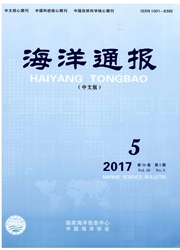

 中文摘要:
中文摘要:
对1985年和1996年鸭绿江口6个站位的水位数据进行调和分析,结果显示,鸭绿江口的潮汐以半日潮为主,M2分潮占优。此外,潮高日不等和涨落潮历时不等的现象较为显著,与实测水位结果一致:由口门向上游方向潮差逐渐减小,落潮历时增大,涨潮历时减小,且落潮历时长于涨潮历时。最下游枢岛验潮站的平均海平面为0.08m;最上游丹东站为1.14m(1985);从下游至上游平均海平面呈现增大趋势,主要原因是鸭绿江口为向上游迅速束窄的狭长形喇叭口,大面潮水涌入后水位被束窄抬升所致。利用调和常数计算的潮位与观测数据基本吻合,表明研究区观测期间水位主要受潮汐作用的控制。
 英文摘要:
英文摘要:
In this paper, water level data from 6 stations at Yalu River Estuary in 1985 and 1996 were analyzed by using the harmonic method. The results show that the tide at Yalu River Estuary is mainly semidiurnal tide, and M2 tide is the dominant component. The tidal range and tidal period are diurnal asymmetry, which is consistent with the measured results. From the fiver mouth to the upstream, tidal range reduces and ebb tide duration lasts increasingly but flood tide duration decreases. The mean sea level significantly increases from downstream to upstream. For example, the mean sea level of the most downstream Shudao station is 0.08 m and the upstream Dandong station is 1.14 m (1985). This may result from the Yalu River Estuarine geomorphology, which is long and narrow and bell-mouthed upward and the water level is uplifted rapidly after large number of tidal water enters narrow trumpet. The water level is calculated by using the harmonic constants according with the observational data showing that the water level in the study area during observational period is mainly controlled by the tide.
 同期刊论文项目
同期刊论文项目
 同项目期刊论文
同项目期刊论文
 期刊信息
期刊信息
